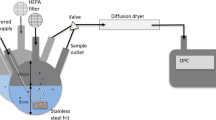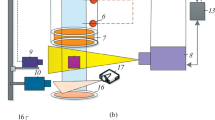Abstract
A theoretical model is presented which allows computing the efficiency with which aerosol particles of 0.001 ≤r≤1 μm are collected by columnar ice crystals in air of various relative humidities, temperatures, and pressures. Particle capture due to Brownian diffusion, thermo- and diffusiophoresis is considered. It is shown that phoretic effects importantly determine the particle capture process of 0.01≤r≤1 μm. The various pressure-temperature levels studied are found to affect the collection efficiency only ifr>0.1 μm. Comparison shows that water drops generally are better aerosol particle scavengers than columnar ice crystals.
Similar content being viewed by others
References
Beard, K. V. (1974),Experimental and numerical collision efficiencies for submicron particles scavenged by small rain drops. J. Atmos. Sci.31, 1595–1603.
Beard, K. V. andGrover, S. N. (1974),Numerical collision efficiencies for small raindrops colliding with micron-sized particles. J. Atmos. Sci.31, 354–550.
Carnuth, W. (1967),Zur Abhaengigheit des Aerosol Partikel Spektrum von meteorologischen Vorgaengen und Zustaende, Arch. f. Meteor. Geophys. Biokl. Ser. A,16, 321–343.
Graedel, T. E. andFraney, J. P. (1975),Field measurements of submicron aerosol washout by snow, Geophys. Res. Lett.2, 325–328.
Greenfield, S. (1957),Rain scavenging of radioactive particulate matter from the atmosphere. J. Meteor.14, 115–125.
Grover, S. N. (1976)A numerical determination of the effect of electric fields and changes on the efficiency with which cloud drops and small drops collide with aerosol particles. Pure and Appl. Geophy.114, 509–520.
Grover, S. N. andBeard, K. V. (1975),A numerical determination of the collision efficiencies of electrically charged water drops colliding with electrically charged aerosol particles. J. Atmos. Sci.32, 2156–2165.
Grover, S. N., Pruppacher, H. R. andHamielec, A. E. (1977),A numerical determination of the efficiency with which aerosol particles collide with spherical water drops in air as a result of hydrodynamic, phoretic, and electric forces, J. Atmos. Sci.34, 1655–1663.
Hall, W. D. andPruppacher, H. R. (1976),The survival of ice particles falling from cirrus clouds in subsaturated air, J. Atmos. Sci.33, 1747–1755.
Itagaki, K. andKoenuma, S. (1962),Altitude distribution of fallout contained in rain and snow, J. Geophys. Res.67, 3927–3933.
Knutson, E. O., Sood, S. K. andStockham, J. D. (1976),Aerosol collection by snow and ice crystals, Atmos. Environment10, 395–402.
Magono, C., Endoh, T., Hariyama, T. andKuboda, S. (1974).A measurement of scavenging effect of falling snow crystals on the aerosol concentration, J. Meteor. Soc., Japan52, 407–416.
Magono, C., Endoh, T. andItasaka, M. (1975),Observation of aerosol particles attached to falling snow crystals. J. Fac. Sci., Hokkaido University4, 103–119.
Pruppacher, H. R. andKlett, J. D. (1978),Microphysics of Clouds, D. Reidell Publ. Co., Dordrecht, Holland, 714 pp.
Reiter, R. (1964),Felder, Stroeme und Aerosole, Verlag D. Steinkopff, Darmstadt, 603 pp.
Reiter, R. andCarnuth, W. (1969),Washout Untersuchungen an Fallout Partikel in der unteren Troposphaere, Arch. f. Meteor., Geophys., Biokl. Ser. A,18, 111–146.
Reiter, R. andCarnuth, W. (1965),Washout balance between 700 and 3000 m above sea level, Preprints, Int. Conf. on Cloud Phys., May 1965, Tokyo and Sapporo, 390–394, available from Meteor. Soc. of Japan, Tokyo.
Sood, S. K. andJackson, M. R. (1960a), Scavenging by snow and ice crystals,Precipitation Scavenging—1972, 121–136. Avail. as Conf.-700601 from Nat. Techn. Info. Service, Springfield, VA.
Sood, S. K. andJackson, M. R. (1969b),Scavenging of atmospheric particulate matter by falling hydrometeors, Int. Conf. on Condensation and Ice Nuclei, 1 Sept, 1969, Prague and Vienna.
Wang, P. K., Grover, S. N. andPruppacher, H. R. (1978),On the effect of electric charges on the scavenging of aerosol particles by cloud and small rain drops. J. Atmos. Sci.35, 1735–1743.
Wang, P. K. (1979),Particular solutions to the steady state diffusion equation and their application in aerosol scavenging problems, Pap. Meteor. Res. (Taipei)2, 37–42.
Author information
Authors and Affiliations
Rights and permissions
About this article
Cite this article
Wang, P.K., Pruppacher, H.R. On the efficiency with which aerosol particles of radius less than 1 μm are collected by columnar ice crystals. PAGEOPH 118, 1090–1108 (1980). https://doi.org/10.1007/BF01593052
Received:
Issue Date:
DOI: https://doi.org/10.1007/BF01593052




